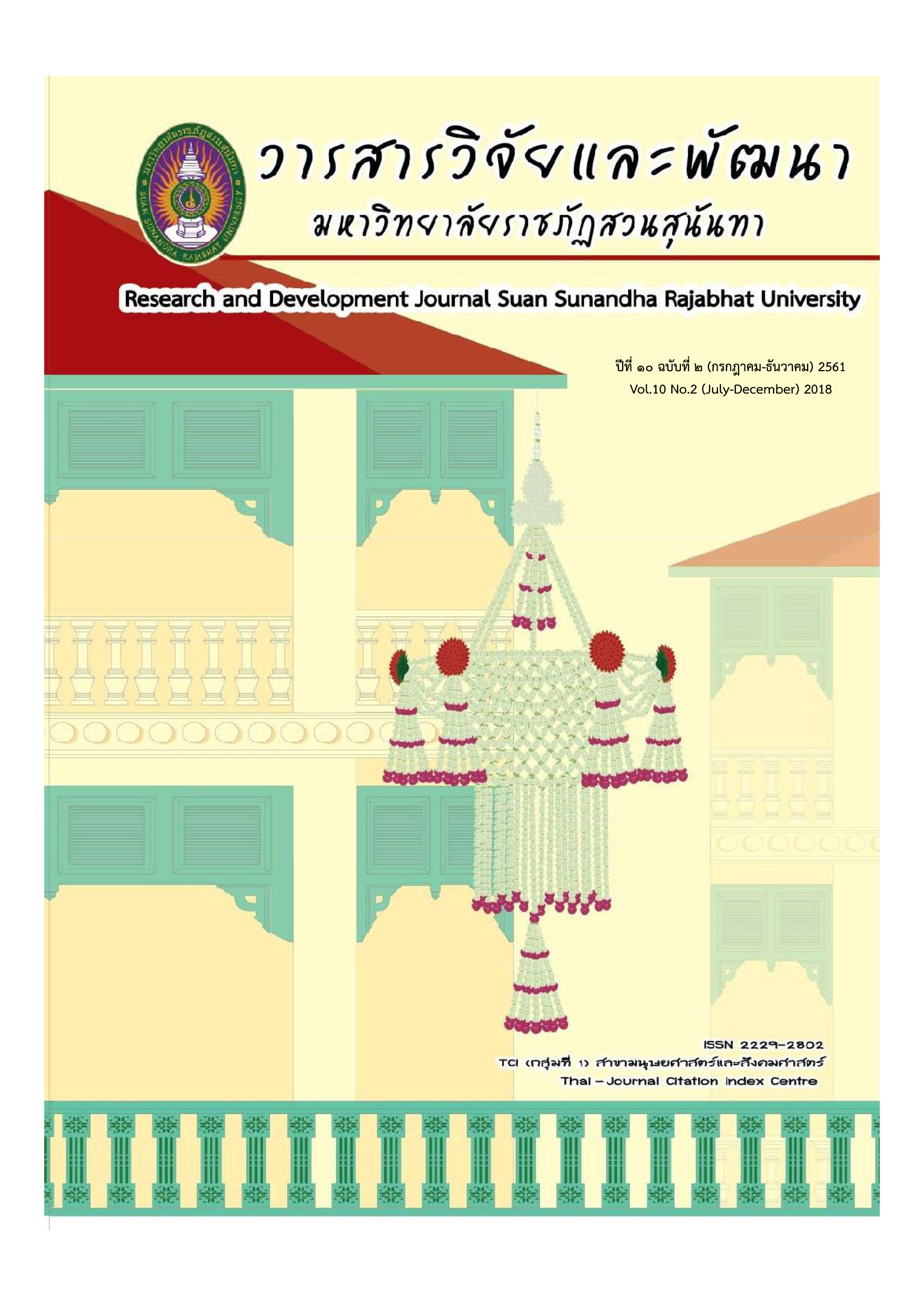รูปแบบกลยุทธ์การตลาดของธุรกิจสปาเพื่อสุขภาพในสถาบันอุดมศึกษาประเทศไทย
DOI:
https://doi.org/10.53848/irdssru.v10i2.163771คำสำคัญ:
กลยุทธ์การตลาด, ธุรกิจสปาเพื่อสุขภาพ, สถาบันอุดมศึกษาบทคัดย่อ
การวิจัยนี้มีวัตถุประสงค์เพื่อพัฒนารูปแบบกลยุทธ์การตลาดของธุรกิจสปาเพื่อสุขภาพในสถาบันอุดมศึกษาประเทศไทย โดยออกแบบการวิจัยเป็นการวิจัยเชิงคุณภาพ เก็บรวบรวมข้อมูลโดยใช้การสัมภาษณ์เชิงลึก ผู้บริหารสถาบันอุดมศึกษา และผู้บริหารสปาเพื่อสุขภาพ จำนวน 10 คน ด้วยแบบสัมภาษณ์แบบไม่มีโครงสร้าง จากนั้นสร้างรูปแบบกลยุทธ์การตลาดของธุรกิจสปาเพื่อสุขภาพในสถาบันอุดมศึกษาประเทศไทย ด้วยวิธีการสนทนากลุ่ม โดยผู้บริหารสถาบันอุดมศึกษา และผู้บริหารสปาเพื่อสุขภาพ ทั้งภาครัฐและเอกชน จำนวน 9 คน และทำการประเมินความเหมาะสมของรูปแบบกลยุทธ์การตลาดของธุรกิจสปาเพื่อสุขภาพในสถาบันอุดมศึกษาประเทศไทย โดยผู้เชี่ยงชาญ จำนวน 8 คน
ผลการวิจัยพบว่าด้านผลิตภัณฑ์ที่นำมาใช้ในธุรกิจสปาจะต้องมาจาก หรือมีส่วนประกอบหลักเป็นวัตถุดิบจากธรรมชาติ โดยผลิตหรือพัฒนาในรูปแบบของภูมิปัญญาท้องถิ่น ด้านราคาผู้รับบริการสามารถเข้าถึงการบริการและผลิตภัณฑ์อย่างคุ้มค่า สมประโยชน์ และชำระค่าบริการด้วยความเต็มใจ ด้านที่ตั้งสถานประกอบการต้องตั้งอยู่ในตำแหน่งที่ผู้รับบริการสามารถมองเห็นและเข้ารับบริการได้ง่าย มีสิ่งอำนวยความสะดวกครบครัน และมีความปลอดภัยเป็นไปตามข้อกำหนดของมาตรฐาน ด้านรายการส่งเสริมการขายมีความหลากหลายรองรับผู้รับบริการกลุ่มต่างๆ ให้ตัดสินใจเข้ารับบริการเพิ่มมากขึ้น ด้านกระบวนการให้บริการทั้งหมดมีมาตรฐาน สามารถสร้างความพึงพอใจ และความประทับใจให้แก่ผู้รับบริการได้ ด้านสิ่งแวดล้อมทางกายภาพและบรรยากาศมีความเป็นไทยตามภูมิภาคและท้องถิ่น โดยผสมผสาน รูป รส กลิ่น เสียง สัมผัส ที่สะท้อนความเป็นสปาไทย และด้านผู้ให้บริการทุกตำแหน่งต้องมีการทักทายแบบไทย ด้วยการไหว้ รอยยิ้มและอัธยาศัย ให้บริการด้วยกริยาที่นุ่มนวล สุภาพ ความใส่ใจ ความตั้งใจ มีทักษะและบริการอย่างมืออาชีพ
เอกสารอ้างอิง
Alen, M. E., Fraiz, J. A. and Rufin,R. (2006). Analysis of Health Spa Customers’ Expectations and Perceptions: The Case of Spanish Establishments. (Online). 1 January 2017 file:///C:/Users/User/Downloads/Analysis_of_health_spa_customers'_expectations_and.pdf
Antimanun, S. (2008). Consumer’s Satisfaction Toward the Using of Services at Phuket Pannara Spa, Phuket Province. Master of Business Administration, Marketing, Suan Dusit Rajabhat University.
Anuwichanont, J. (2009). The Impact of Perceived Value on Spa Loyalty and Its Moderating Effect of Destination Equity. Journal of Business and Economics Research. 7(12), 73-90.
Athena, H. N. Mak, Kevin, K. F. Wong and Richard, C. Y. Chang. (2009). “Health or Self-Indulgence? The Motivations and Characteristics of Spa-goers.” Int. J. Tourism Res. 11, 185-199.
Barhey, S. (2012). Marketing Factors Affecting Chinese Travelers’ Decision to Use Spa in Thailand: A Case Study of Phuket Province. Master of Business Administration, Marketing, Phuket Rajabhat University.
Boonprasert, C. (2004). Spa Service for Health and Beauty Proposes in Bangkok Metropolitan Area from The Perspectives of Consumers. Master of Business Administration, Marketing, Srinakharinwirot University.
Boonsom, R. (2007). The Operations of Health Spa Businesses in Chiang Mai. Master of Business Administration, Business Administration, Chiang Mai University.
Butsrichart, J. (2008). Marketing plan of Beauty and Medical Spa. Master of Business Administration, Business Administration, Naresuan University.
Chaivissit, P. (2006). Roles of Health Spa Enterprises in Promoting Chiang Mai as a Health Care Center. Master of Arts, Political Economy, Chiang Mai University.
Didascalou, E. A, Nastos, P. T. and Matzarakis, N. A. (2007). Spa Destination Development Using a Decision Support System-The Role of Climate and Bioclimate Information. Development in Tourism Climatology. (Online). 1 January 2017 http://www.urbanclimate.net/matzarakis/papers/dTcl_2007_didaskalouetal.pdf
Hidayattullah, R., Sundjaya, Y. and Santhika, I. (2013). Brand Positioning in Measuring Effectiveness Promotion: A survey on visitors Ciater Spa Resorts Subang West Java. International Journal of Science and Research. 2(1), 712-717.
Hirankitti, P, Mejinda, P and Manjing, S. (2007). Marketing Strategies of The Operators, Factors on The Selection of a Spa, and The Behavior of The Spa Users. Faculty of Rajamangala University of Technology Thanyaburi.
Kim, S. H., Kim, S. H., Huh, C and Knutson, B. 2010. A Predictive Model of Behavioral Intention to Spa Visiting: An Extended Theory of Planned Behavior. (Online). 1 January 2017 http://scholarworks.umass.edu/cgi/viewcontent.cgi?article=1526&context=refereed
Kitjanulug, J. (2007). Marketing Strategy of First Class Spa Business in Thailand. Master of Business Administration, Management Sciences, Sukhothai Thammathirat Open University.
Langviniene, N. and Sekliuckiene, J. (2009). Factors of Influence on Successful Development of Lithuanian Resort Wellness SPA Services. Social Science/Socialiniai Mokslai. 4(66), 72-81.
Ministry of Public Health. (2015). Reported number of establishments certified in 2014. Online 9 June 2015 URL: http://mrd.hss.moph.go.th/uploadFiles/document/D00000001434_26097.pdf
Mohan, V. and Kumar, S. (2015). Derterminants of Spa Popularity. International Journal of Management and Commerce Innoventions. 2(2), 524-530.
Okech, R. N. (2014). Promoting the Spa Tourism Industry: Focus on Coastal Resorts in Kenya. Athens Journal of Tourism. 1(1), 67-77.
Planning Division. Department of Health Service Support. Ministry of Public Health. (2015). Spa Business Guide. Online 9 June 2015 URL: httppmsn.hss.moph.go.thuploadFilesdocumentD00000000403_23745.pdf
Small&Medium Industrial Institute. (2004). Day Spa...Health Service Business. Bangkok: P2 Design&Print Co., Ltd.
The Hartman Group. (2004). ISPA 2004 Consumer Trends Report (Online). 15 February 2009 www.globalspasummit.org/2009/resouraces/
Tungthongsawang, W. (2009). Marketing Mix to Choose Spa of Amphor Muang Chacheongsao Province. Master of Business Administration, Management Sciences, Sukhothai Thammathirat Open University.
Unseen Planet Co.,LTD. (2006). Spa in Paradise. Samut Prakan: Tac. Offset Printing Co.,LTD.
Wannaree, P. and Surarak, K. (2012.). Possibility of Thai Spa Success in German Market. (Online). 15 February 2017 http://journal.rmutp.ac.th/wp-content/uploads/2014/06/Special-Business_Administration-Inter-49.pdf
Yam-iam, K. (2011). Service Marketing Mix Factors Affecting Customers Towards Selecting Healthy Spas in Khet Watthana, Bangkok. Master of Business Administration, Business Administration, Chiang Mai University.
ดาวน์โหลด
เผยแพร่แล้ว
รูปแบบการอ้างอิง
ฉบับ
ประเภทบทความ
สัญญาอนุญาต
บทความที่ได้รับการตีพิมพ์เป็นลิขสิทธิ์ของ สถาบันวิจัยและพัฒนา มหาวิทยาลัยราชภัฎสวนสุนันทา
ข้อความที่ปรากฏในบทความแต่ละเรื่องในวารสารวิชาการเล่มนี้เป็นความคิดเห็นส่วนตัวของผู้เขียนแต่ละท่านไม่เกี่ยวข้องกับมหาวิทยาลัยราชภัฎสวนสุนันทา และคณาจารย์ท่านอื่นๆในมหาวิทยาลัยฯ แต่อย่างใด ความรับผิดชอบองค์ประกอบทั้งหมดของบทความแต่ละเรื่องเป็นของผู้เขียนแต่ละท่าน หากมีความผิดพลาดใดๆ ผู้เขียนแต่ละท่านจะรับผิดชอบบทความของตนเองแต่ผู้เดียว





